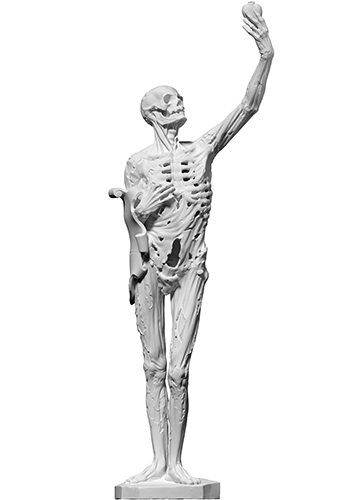Oliver Laric “TF”
December 18, 2015 – January 23, 2016
Gallery Hours :11:00 – 19:00
Gallery Closed:
Sunday, Monday, Public Holiday
Reception:December 18, 2015 18:00 – 20:00

Image courtesy of the artist and Tanya Leighton, Berlin
Kaikai Kiki Gallery is pleased to present TF, a solo exhibition by Berlin-based artist Oliver Laric. Exploring duplication and transformation through a varied practice that includes sculpture, video, animation, and web-based projects, Laric’s work articulates an increasingly pervasive sense of fluidity in our relationship with images and objects, including our own bodies.
In TF, Laric will show an as yet untitled 2014 video work. The video depicts tracings of animated sequences appropriated from other films. The animated sequences portray bodies involuntarily morphing from one form to another, such as a grown man turning into a baby, or a cobra transforming into a man.
To create this effect, Laric extracts existing scenes from films, and traces vector outlines of the animated morphing bodies. He then visually suspends these vector graphic animations against a white background, divorced from their original backgrounds and narrative contexts, and replays the series of sequences with a melancholy soundtrack.
The musical score communicates to the viewer that we are watching a painful process, a brief moment of duress slowed down to an eerie, erotic pace. These bodies do not opt for transition; this flesh is stuff, image-material, beyond its occupant’s control. Interspersed between these extracts, we see 3D renderings of furry fetish illustrations and hybrid human forms Laric commissioned from artists he met through various online galleries of user-created images – an image category referred to in online communities as transformation art, or “TF”..
In addition to the video work, Laric continues an ongoing series in which he creates three-dimensional scanned models of sculptural objects from institutional archives. He then makes the 3D models available on the internet, for free and unlimited use by the public for any purpose, commercial or otherwise. In this most recent iteration, Laric has scanned a plaster copy of Riger Lichier’s Transi de René Chalon.
The original 1547 funerary statue, in St. Stephen’s Church in Bar-le-Duc, was a posthumous portrait sculpture of the Prince d’Orange, depicted as a decaying skeletal corpse clutching his own heart aloft (originally, the Prince’s exhumed organ was contained in a small reliquary vessel in his palm).
Laric, however, has scanned a heartless, 19th century plaster duplicate, made for the Musée National des Monuments Français in Paris. Beginning with the 3D model of the plaster duplicate, Laric produced a small-scale bas relief comprised of the same polyurethane and powdered metal mix used to make faux marble. The sculpture is, thus, a modified reproduction of a copy, composed of composite synthetic materials intended to mimic a classical “fine art” medium – resulting in a kind of grotesque of duplication.
While 3D modeling refers back to the classic sculptural process of casting, the broad availability of 3D printing threatens to undermine recognizable chains of production, and indeed, the potential for a unique object.
Moving further away from its source, the decaying corpse-object of the Prince becomes less and less a memorial, more and more a product. Maybe beneath the pretense of creation lies the urge to mummify. Perhaps duplication here becomes a kind of putrefaction, as one form consumes and replaces the remains of its predecessor. Laric literalizes the idea of memory as a physical process – “re-member-ing” – that gives the disembodied a new body.
If a deep sense of flux permeates not only how we perceive images and objects, but also who we are, then what TF are we? There is a Buddhist maxim that concludes: “This thing we call a corpse, so fearful to behold, is already right here – our own body.”
Both in his video and his faux-marble relief of the Transi, bodily flesh presents, as it transitions or decays, the complicated process of becoming material, “permanent and perishing, ripe and decaying.” For Laric, the replica or duplicate is always a mutation, remaining in a potential state; a perpetual condition of becoming.
Andrea Neustein